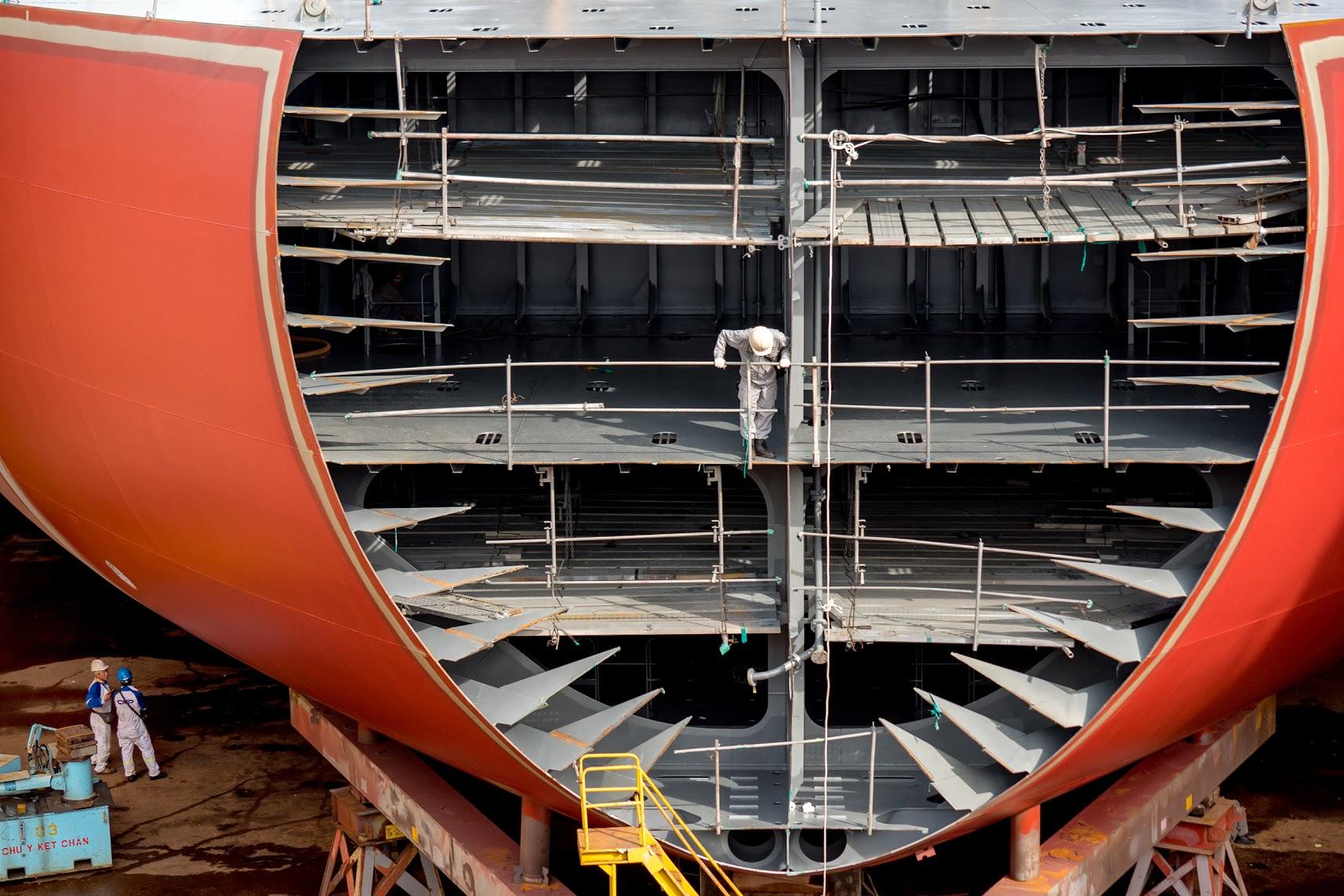Swiss merchant navy celebrates 75th anniversary
World shipping is going through one of the worst crises in its history. Ship-owners flying the flag of Switzerland are also hit. As the Swiss commercial fleet celebrates three-quarters of a century, dark clouds gather on the horizon.
They were named after famous Swiss people or mountains, such as General Guisan, Matterhorn, Moléson or Monte Rosa.
On all the seas of the world, cargo ships carry at their sterns the red flag with a white cross. Whereas most German, French or Spanish commercial ships have been sailing on for ages under Panamanian or Liberian flags of convenience, Switzerland can take pride in having had its own commercial fleet for the past 75 years.
For obvious reasons, with 49 vessels and a world transport capacity share of no greater than 0.1%, Switzerland does not claim to compete with the merchant navies of Greece or Malta, and their thousands of ocean-going cargo ships. But it has the largest commercial fleet of any landlocked country in the world, ahead of Mongolia.
Even the Swiss are unfamiliar with this peculiarity, which dates back to the Second World War.
“The idea was to supply basic commodities during the war. The Swiss flag, a symbol of neutrality, was supposed to escape the bombing and torpedoes from German and allied submarines yet two Swiss ships were sunk by the British,” says journalist Olivier Grivat, co-author of “Marine Suisse: 75 Ans sur les Océans“, which has just been published by the ImagineExternal link Agency.
Credit in jeopardy
Three-quarters of a century later, the mission of the Swiss merchant navy remains unchanged. Its mandate is still to provide Switzerland with goods that would be in short supply in case of a major crisis. That, at least, is the theory, because the only time it considered enlisting the help of the Swiss merchant fleet was nearly 50 years ago, during the Six Day War between Israel and Egypt.
The fact remains that the six private companies that own and manage a fleet of bulk carriers, chemical tankers, and multi-purpose vessels flying the Swiss flag must to this day be ready at all times to change their cargo and alter their itinerary at Bern’s behest.

More
Swiss sea giants hatch in Vietnam
In exchange for their flexibility, the Swiss government provides loan guarantees of up to CHF1.1 billion ($1.1 billion) to help ship-owners buy new vessels, although it does not subsidise the fleet directly. Thanks to these guarantees, Swiss ship-owners enjoy preferential interest rates from banks.
Yet this credit facility, in which the state acts as a guarantor and which elapses in June 2017, is politically controversial. There is no certainty that the government will support its renewal.
In Basel, which is the Swiss merchant navy’s virtual home port (no ocean-going vessel has ever gone up the Rhine) and the headquarters of the Swiss Maritime Navigation Office (SMNO)External link, Reto Dürler admits that times have changed.
“With trade liberalisation and globalisation, there is less of a need for a Swiss fleet than in the past. It is now up to politicians to decide whether or not they want to retain that flag and in what form,” the director of the SMNO says.
“Worst recession in history”
But there is another reason why the Confederation may decide against renewing its indirect financial support for the Swiss merchant navy. For the first time ever, it is increasingly likely that it will have to provide financial help to struggling Swiss ship-owners.
“Shipping is going through the worst recession in its history. All ship-owners, whether Swiss or foreign, are facing the same challenge,” says Eric André, chairman of the Swiss Ship-owners Association (AAS) and CEO of the Société Suisse-AtlantiqueExternal link.
This can be explained by the fall in commodity prices but also the excessive number of ever-larger vessels launched since the buoyant years of 2003-2008.
The statistics provided by Eric André who, with 16 vessels, manages the largest fleet of ships flying the flag of Switzerland, are stark.
“At the end of 2008, before the world economic crisis, the charter rate for a ship of a carrying capacity of 70,000 tonnes could reach $100,000 per day. Today, the average rate is $3,500, while operational costs amount to $6,500, excluding depreciation and interest expense. Every day, ship-owners around the world lose huge sums of money.”
André will not comment on the economic situation of the other Swiss ship-owners, but there are rumours that one of them is believed to be walking a tightrope. A financial rescue by Bern in its capacity as lender of last resort would signal the end of political support for credit and, as a knock-on effect, for the Swiss navy, says Olivier Grivat.
“Because the only real reason why ship-owners are keen to fly the flag of Switzerland is the financial guarantee provided by the Confederation,” the journalist says.
Smaller, but still standing
The red flag with a white cross may be a trademark and a quality logo – a guarantee that goods will reach port without being damaged. But this argument is far from being good enough in the highly competitive shipping market. If proof were needed, most of the ship-owners operating on Swiss territory, such as Mediterranean Shipping CompanyExternal link (MSC), which owns the world’s four largest container ships, sail under the flags of other nations.
Is this the end of the Swiss navy? Dürler does not like to think so.
“With 49 ships, we have reached a peak of sorts. If the credit facility is not renewed, the fleet will be resized but it will not disappear. For decades, 15 to 25 vessels sailed under the flag of Switzerland. This is a respectable number for a landlocked country.”
Up to 611 Swiss nationals worked in the national navy in 1967, while only six do so today. That is fewer than 1% of the 868 seamen employed on the 49 vessels flying the flag of Switzerland.
Seafaring has become less attractive over the past few decades, says Reto Dürler, the director of the Swiss Maritime Navigation Office.
“Nowadays, young people can explore the world with cheap charter flights without having to leave their families for months on end. The stress of life on ships, low wages, short turnarounds and ports located further and further away from cities have also put off Swiss nationals.”
It is true that things looked up during the 1990s, when several hundred young Swiss seamen were taken on. The Swiss government had decided that, over a five-year period, it would fund the difference between wages paid to people on board ships and people on shore doing similar work. But these days are gone. The meagre CHF20,000 credit granted by Bern to the young Swiss who attend a nautical officers academy abroad will be crossed out from the government’s next cost-saving programme.
Translated from French by Beatrice Murail

In compliance with the JTI standards
More: SWI swissinfo.ch certified by the Journalism Trust Initiative













You can find an overview of ongoing debates with our journalists here . Please join us!
If you want to start a conversation about a topic raised in this article or want to report factual errors, email us at english@swissinfo.ch.